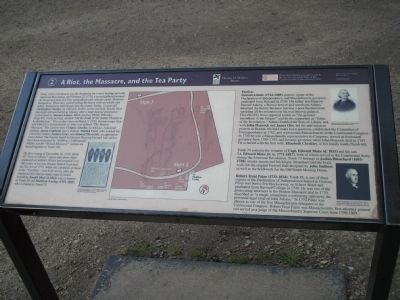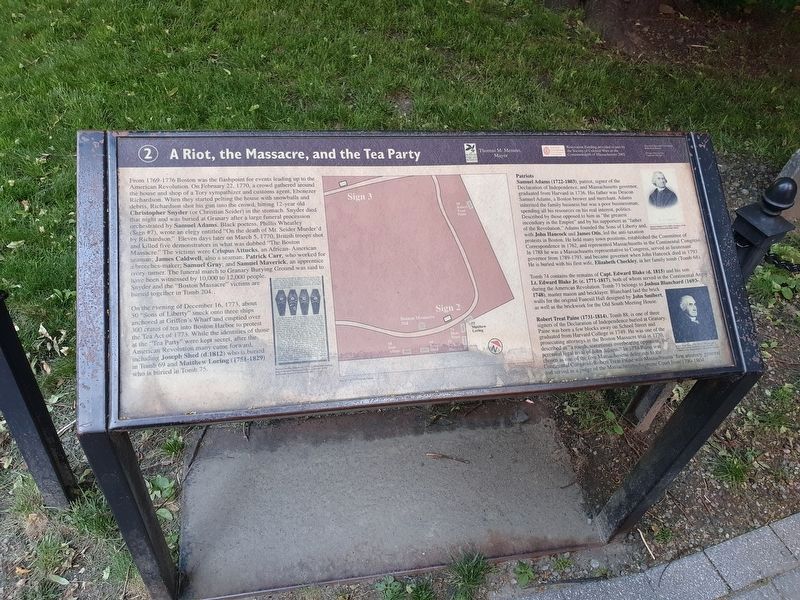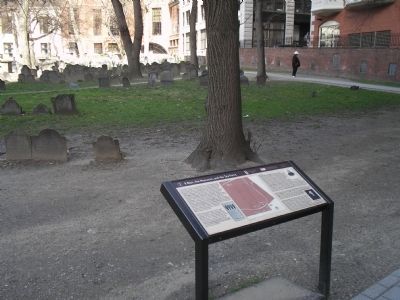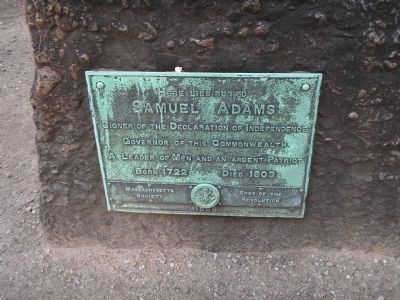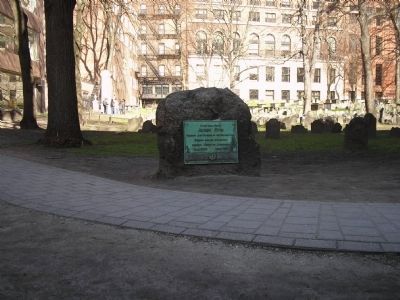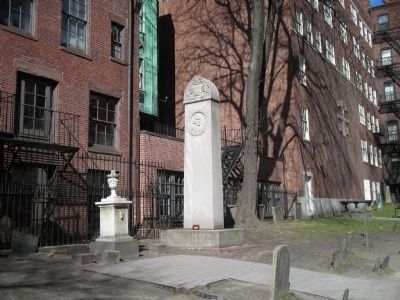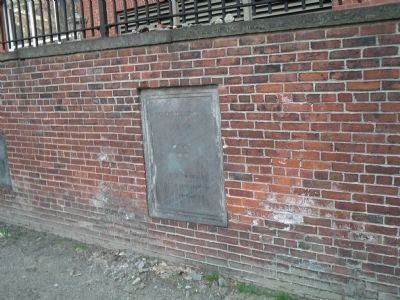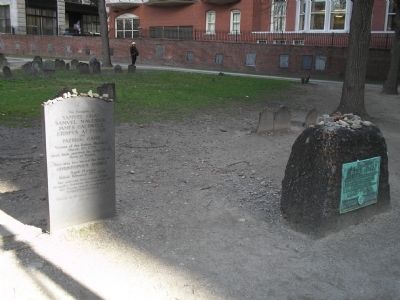Downtown in Boston in Suffolk County, Massachusetts — The American Northeast (New England)
A Riot, the Massacre, and the Tea Party
On the evening of December 16, 1773, about 50 “Sons of Liberty” snuck onto three ships anchored at Griffen’s Wharf and emptied over 300 crates of tea into Boston Harbor to protest the Tea Act of 1773. While the identities of those at the “Tea Party” were kept secret, after the American Revolution many came forward, including Joseph Shed (d. 1812) who is buried in Tomb 69 and Matthew Loring (1751-1829) who is buried in Tomb 75.
Patriots
Samuel Adams (1722-1803), patriot, signer of the Declaration of Independence, and Massachusetts governor, graduated from Harvard in 1736. His father was Deacon Samuel Adams, a Boston brewer and merchant. Adams inherited the family business but was a poor businessman, spending all his resources on his real interest, politics. Described by those opposed to him as “the greatest incendiary in the Empire” and by his supporters as “father of the Revolution,” Adams founded the Sons of Liberty and, with John Hancock and James Otis, led the anti-taxation protests in Boston. He held many town positions, established the Committee of Correspondence in 1762, and represented Massachusetts in the Continental Congress. In 1788 he was a Massachusetts representative to Congress, served as lieutenant governor from 1789-1793, and became governor when John Hancock died in 1793. His is buried with his first wife, Elizabeth Checkley, in her family tomb (Tomb 68).
Tomb 74 contains the remains of Capt. Edward Blake (d. 1815) and his son Lt. Edward Blake Jr. (c. 1771-1817), both of whom served in the Continental Army during the American Revolution. Tomb 73 belongs to Joshua Blanchard (1693-1748), master mason and bricklayer. Blanchard laid the brick walls for the original Faneuil Hall designed by John Smibert, as well as the brickwork for the Old South Meeting House.
Robert Treat Paine (1731-1814), Tomb 88, is one of three signers of the Declaration of Independence buried at Granary. Paine was born a few blocks away on School Street and graduated from Harvard College in 1749. He was one of the prosecuting attorneys in the Boston Massacre trial in 1770, described as “a rough, sometimes overbearing opponent, the perennial legal rival of John Adams.” In 1774 Paine was chosen as one of the five Massachusetts delegates to the Continental Congress. Robert Treat Paine was Massachusetts’ first attorney general and served as a judge of the Massachusetts Supreme Court from 1790-1804.
Topics and series. This historical marker is listed in these topic lists: Cemeteries & Burial Sites • Colonial Era • Patriots & Patriotism • War, US Revolutionary. In addition, it is included in the Former U.S. Presidents: #02 John Adams series list. A significant historical month for this entry is February 1767.
Location. Marker has been reported missing. It was located near 42° 21.446′ N, 71° 3.669′ W. Marker was in Boston, Massachusetts, in Suffolk County. It was in Downtown. Marker was at the intersection of Tremont Street and Bromfield Street, on the left when traveling north on Tremont Street. Marker is along the walking trail in Granary Burying Ground. Touch for map. Marker was in this post office area: Boston MA 02108, United States of America. Touch for directions.
Other nearby markers. At least 8 other markers are within walking distance of this location. Samuel Adams (a few steps from this marker); Victims of the Boston Massacre (a few steps from this marker); John Smibert (a few steps from this marker); John Phillips (a few steps from this marker); Granary Burial Ground (within shouting distance of this marker); Granary Burying Ground (within shouting distance of this marker); Paul Revere Buried in this Ground (within shouting distance of this marker); Tremont Temple (within shouting distance of this marker). Touch for a list and map of all markers in Boston.
More about this marker. The right side of the marker contains a copy of a Boston Gazette propaganda piece from March 12, 1770 about the Boston Massacre. The right side of the marker features portraits of Samuel Adams and Robert Treat Paine. A partial map of the cemetery showing the location of the marker and several of the graves mentioned on the marker is at the bottom center.
Related markers.
Click here for a list of markers that are related to this marker. Take a tour of the markers found along the walking trail in Boston’s Granary Burying Ground.
Also see . . . Granary Burying Ground. Details of the Freedom Trail from the City of Boston website. (Submitted on May 9, 2009, by Bill Coughlin of Woodland Park, New Jersey.)
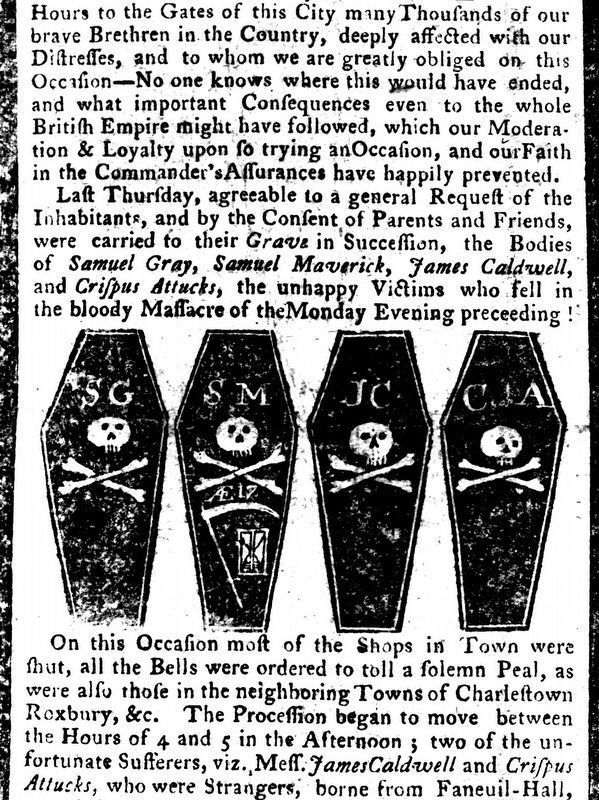
Library of Congress
5. Four coffins of Men Killed in the Boston Massacre
“The Bodies of Samuel Gray, Samuel Maverick, James Caldwell, and Crispus Attucks, the unhappy victims who fell in the bloody Massacre of the Monday Evening preceeding.”
Engraved by Paul Revere from The Boston Gazette, and Country Journal, March 12, 1770.
Engraved by Paul Revere from The Boston Gazette, and Country Journal, March 12, 1770.
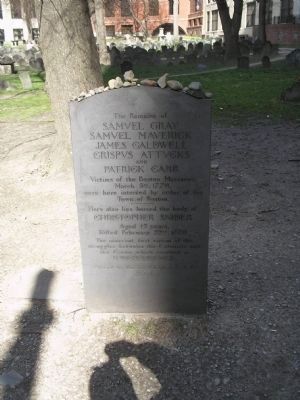
Photographed By Bill Coughlin, April 14, 2009
9. Victims of the Boston Massacre
Samuel Gray
Samuel Maverick
James Caldwell
Crispus Attucks
and
Patrick Carr
Victims of the Boston Massacre,
March 5th, 1770,
were here interred by order of the
Town of Boston.
----------
Here also lies buried the body of
Christopher Snider
Aged 12 years,
Killed February 22nd, 1770
The innocent victim of the
struggles between the Colonists and
the Crown, which resulted in
INDEPENDENCE.
----------
Placed by Boston Chapter D.A.R.
1906.
Credits. This page was last revised on January 30, 2023. It was originally submitted on May 9, 2009, by Bill Coughlin of Woodland Park, New Jersey. This page has been viewed 3,435 times since then and 66 times this year. Photos: 1. submitted on May 9, 2009, by Bill Coughlin of Woodland Park, New Jersey. 2. submitted on July 11, 2021, by J. Makali Bruton of Accra, Ghana. 3, 4. submitted on May 9, 2009, by Bill Coughlin of Woodland Park, New Jersey. 5. submitted on April 3, 2021, by Allen C. Browne of Silver Spring, Maryland. 6, 7, 8, 9, 10. submitted on May 9, 2009, by Bill Coughlin of Woodland Park, New Jersey.
